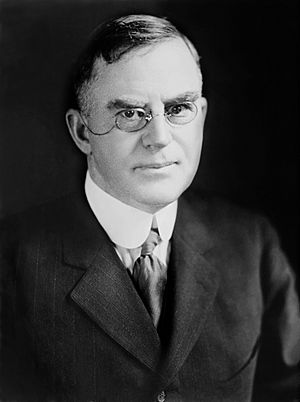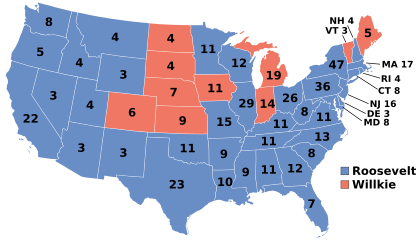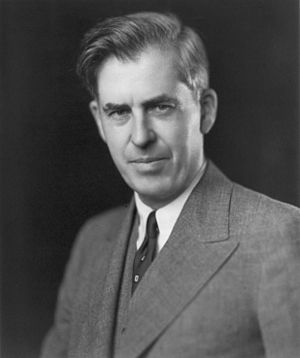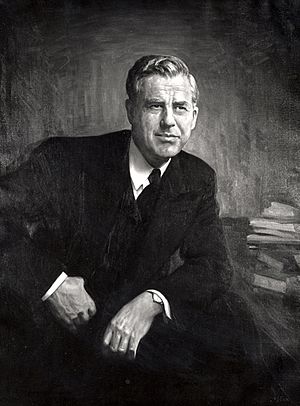Henry A. Wallace facts for kids
Quick facts for kids
Henry A. Wallace
|
|
|---|---|
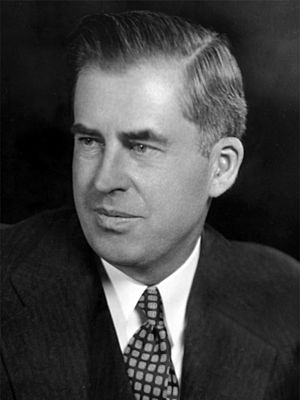
Official portrait, c. 1941–1945
|
|
| 33rd Vice President of the United States | |
| In office January 20, 1941 – January 20, 1945 |
|
| President | Franklin D. Roosevelt |
| Preceded by | John Nance Garner |
| Succeeded by | Harry S. Truman |
| 10th United States Secretary of Commerce | |
| In office March 2, 1945 – September 20, 1946 |
|
| President |
|
| Preceded by | Jesse H. Jones |
| Succeeded by | W. Averell Harriman |
| Chair of the Supply Priorities and Allocations Board | |
| In office August 28, 1941 – January 16, 1942 |
|
| President | Franklin D. Roosevelt |
| Preceded by | Office established |
| Succeeded by | Office abolished |
| Chair of the Board of Economic Warfare | |
| In office July 2, 1940 – July 15, 1943 |
|
| President | Franklin D. Roosevelt |
| Preceded by | Office established |
| Succeeded by | Office abolished |
| 11th United States Secretary of Agriculture | |
| In office March 4, 1933 – September 4, 1940 |
|
| President | Franklin D. Roosevelt |
| Preceded by | Arthur M. Hyde |
| Succeeded by | Claude R. Wickard |
| Personal details | |
| Born |
Henry Agard Wallace
October 7, 1888 Orient, Iowa, U.S. |
| Died | November 18, 1965 (aged 77) Danbury, Connecticut, U.S. |
| Resting place | Glendale Cemetery |
| Political party |
|
| Other political affiliations |
Progressive "Bull Moose" (1912) |
| Spouse |
Ilo Browne
(m. 1914) |
| Children | 3 |
| Parent |
|
| Education | Iowa State University (BS) |
| Signature | |
Henry Agard Wallace (born October 7, 1888 – died November 18, 1965) was an important American politician, farmer, and businessman. He served as the 33rd Vice President of the United States under President Franklin D. Roosevelt. He also held key roles as the 11th United States Secretary of Agriculture and the 10th United States Secretary of Commerce. Later, he ran for president in 1948 with the new Progressive Party.
Henry A. Wallace was born in rural Iowa. His father, Henry Cantwell Wallace, was also a U.S. Secretary of Agriculture. After college, Henry A. Wallace worked for his family's farm magazine, Wallaces' Farmer. He also started the Hi-Bred Corn Company, which became very successful by developing special kinds of corn. Wallace was interested in many subjects, including science and different spiritual ideas. He started as a Republican but later supported Democrat Franklin D. Roosevelt in the 1932 election.
Wallace became Secretary of Agriculture under Roosevelt from 1933 to 1940. He helped create the New Deal farm policies, which aimed to help farmers during the Great Depression. In 1940, Roosevelt chose Wallace as his running mate, and they won the election. However, in 1944, other Democratic leaders chose Harry S. Truman instead of Wallace for vice president. In 1945, Roosevelt appointed Wallace as Secretary of Commerce.
After Roosevelt died in 1945, Truman became president. Wallace continued as Secretary of Commerce until 1946. Truman fired him because Wallace publicly disagreed with the government's tough stance against the Soviet Union. Wallace then formed the Progressive Party and ran for president in 1948. His party wanted friendly relations with the Soviet Union, desegregation, racial and gender equality, and national health care. He faced criticism for his views and received only a small percentage of the vote. Wallace later left the Progressive Party and focused on his successful farming business. He died in 1965.
Contents
Early Life and Education
Henry Agard Wallace was born on October 7, 1888, on a farm near Orient, Iowa. His parents were Henry Cantwell Wallace and May Wallace. He had two younger brothers and three younger sisters. His grandfather, "Uncle Henry" Wallace, was a well-known farmer and newspaper editor.
In 1892, his family moved to Ames, Iowa, and then to Des Moines, Iowa, in 1896. In 1894, the Wallaces started an agricultural newspaper called Wallace's Farmer. This newspaper became very popular and made the family wealthy and influential. From a young age, Henry was very interested in farming and plants. He became friends with African-American botanist George Washington Carver, and they often talked about plants.
Wallace was especially interested in corn, which was a very important crop in Iowa. In 1904, he did an experiment that showed that the prettiest corn didn't always produce the most grain. In 1906, he graduated from high school and started studying animal husbandry at Iowa State College. He spent a lot of his free time studying corn.
Journalist and Farmer
After graduating from college in 1910, Wallace became a full-time writer and editor for Wallace's Farmer. He was very interested in using math and economics to understand farming. He even studied calculus to better understand hog prices. He also wrote an important article about using statistics in farming.
In 1916, after his grandfather died, Wallace and his father became co-editors of the newspaper. In 1921, Wallace took over the paper when his father became Secretary of Agriculture. Wallace stopped being an editor in 1933 during the Great Depression.
In 1914, Wallace and his wife bought a farm in Iowa. They focused on growing hybrid corn. In 1923, he made the first-ever deal to produce hybrid seeds. In 1926, he helped start the Hi-Bred Corn Company to develop and sell hybrid corn. This company started small but eventually became a huge success.
Early Political Involvement
During World War I, Wallace and his father helped the government create plans to increase hog production. After the war, Wallace wrote a book called Agricultural Prices. In it, he suggested that the government should help control farm prices. He also warned farmers that prices would soon drop, which turned out to be true.
To help with the farm crisis, Wallace suggested an "ever-normal granary" plan. This idea meant the government would buy and store extra farm products when prices were low. Then, they would sell them when prices were high. This would help keep prices stable for farmers.
Wallace supported the McNary–Haugen Farm Relief Bill, which would have helped farmers sell their extra crops overseas. However, President Calvin Coolidge vetoed the bill twice. After his father died in 1924, Henry Wallace voted for the Progressive candidate, Robert M. La Follette.
The Great Depression hit Iowa farmers very hard. Their income dropped by two-thirds between 1929 and 1932. In the 1932 election, Wallace supported Democrat Franklin D. Roosevelt. Roosevelt agreed with Wallace's ideas for helping farmers. Wallace officially became a Democrat in 1936.
Secretary of Agriculture
After Roosevelt won the 1932 election, he made Wallace the Secretary of Agriculture. Wallace strongly supported Roosevelt's New Deal plan to help the country recover from the Depression. One of Wallace's first big projects was the Agricultural Adjustment Act (AAA). This law aimed to raise prices for farm products by paying farmers to grow less. This helped reduce extra crops and increase farm income.
In 1936, the Supreme Court ruled that the AAA was unconstitutional. Wallace disagreed with this decision. He quickly proposed a new farm program. This new plan paid farmers to plant green manure (crops that improve the soil) instead of regular crops like corn and wheat. This new law, the Soil Conservation and Domestic Allotment Act of 1936, was signed soon after.
Wallace also worked to help poor farmers, especially sharecroppers in the South. He helped pass the Bankhead–Jones Farm Tenant Act of 1937. This law allowed the government to give loans to tenant farmers so they could buy their own land and equipment. It also created the Farm Security Administration to help reduce poverty in rural areas.
In 1938, Wallace helped pass the Agricultural Adjustment Act of 1938, which put his "ever-normal granary" plan into action. By 1940, the Agriculture Department had grown significantly under Wallace's leadership.
As World War II began in Europe, Wallace supported Roosevelt's efforts to prepare for war. He pushed for programs like making synthetic rubber and improving trade with Latin American countries.
Vice Presidency (1941–1945)
Election of 1940
In 1939, Wallace publicly supported Roosevelt running for a third term as president. At the 1940 Democratic National Convention, Roosevelt insisted that Wallace be his vice president. Even though Wallace was new to the Democratic Party and not very popular with some party leaders, Roosevelt believed in him. Wallace had strong support from farmers and was loyal to Roosevelt's policies.
Wallace won the nomination for vice president. He left his job as Secretary of Agriculture in September 1940. During the election campaign, Wallace traveled around the Midwest, giving speeches. He focused on foreign affairs, saying that replacing Roosevelt would make Adolf Hitler happy. Roosevelt and Wallace won the 1940 election by a large margin. After the election, Wallace visited Mexico as a goodwill ambassador. He gave a well-received speech about friendship between American countries.
Time as Vice President
Wallace became vice president on January 20, 1941. He soon felt frustrated with his job, which mostly involved leading the United States Senate. In July 1941, Roosevelt gave Wallace more important roles. He made him chairman of the Board of Economic Warfare (BEW) and the Supply Priorities and Allocations Board (SPAB). These jobs gave Wallace a say in preparing the country for war. Many journalists started calling him the "Assistant President."
Wallace also advised Roosevelt on the development of nuclear weapons. He supported this project. However, Wallace faced challenges in his role. He had disagreements with other government officials, especially Jesse H. Jones, the Secretary of Commerce. These disagreements were often public. Roosevelt usually liked to have different people in similar roles to encourage debate, but he eventually removed both Wallace and Jones from their war production roles in 1943. This was a big setback for Wallace.
On May 8, 1942, Wallace gave his most famous speech, known as "the Century of the Common Man." He said that World War II was a fight between a "free world" and a "slave world." He believed that peace should bring a better life for everyone, not just in the United States and England, but also in places like India, Russia, China, and Latin America. This speech was translated into many languages and shared worldwide.
In 1943, Wallace went on a goodwill tour of Latin America. He was very well received, partly because he could give speeches in Spanish. During his trip, several Latin American countries declared war on Germany. Back home, Wallace continued to speak out for progressive ideas. He said that Americans could not fight against Nazi cruelty abroad and ignore race riots at home.
In 1944, Wallace toured the Soviet Union and China. He was impressed by what he saw in the Soviet Union, but he struggled to negotiate with Chinese leader Chiang Kai-shek.
Election of 1944
As Roosevelt's health declined, many wondered if Wallace would be kept as vice president for the 1944 election. Polls showed Wallace was the most popular choice among Democrats. However, many party leaders wanted to remove him. They disliked his strong views against racial segregation and his unusual religious beliefs.
Before the 1944 Democratic National Convention, party leaders convinced Roosevelt to support either William O. Douglas or Harry S. Truman for vice president. However, Wallace also got Roosevelt to send a letter saying he would personally vote for Wallace.
At the convention, Wallace gave a powerful speech. He said that the future belonged to those who supported freedom and fairness for everyone, "regardless of race, color, or religion." Despite his popularity with the crowd, party leaders worked hard to get Truman nominated. On the first vote, Wallace received the most votes but not enough to win. On the second vote, many delegates switched to Truman, giving him the nomination.
On January 20, 1945, Wallace swore in Truman as the new vice president.
Secretary of Commerce (1945–1946)
Wallace felt that Democratic leaders had unfairly taken the vice-presidential nomination from him. However, he still supported Roosevelt in the 1944 election. Roosevelt wanted to improve his relationship with Wallace, so he offered him a Cabinet position. Wallace chose to become Secretary of Commerce. He hoped to help guide the economy after the war.
In January 1945, Roosevelt nominated Wallace for the job. Many senators opposed him because of his liberal ideas. They failed to block his nomination, but they did remove the Reconstruction Finance Corporation from the Commerce Department. Wallace was confirmed as Secretary of Commerce on March 1, 1945.
Roosevelt died on April 12, 1945, and Truman became president. Truman kept Wallace in his Cabinet because Wallace was very popular with liberal Democrats. As Secretary of Commerce, Wallace supported a "middle course" for the economy. He wanted to avoid both the strict government control of the Soviet Union and the hands-off approach of the past. He helped pass the Employment Act of 1946, which created the Council of Economic Advisers to study the economy. He also helped pass the Atomic Energy Act of 1946, which set up the United States Atomic Energy Commission to manage nuclear power.
After World War II ended, relations with the Soviet Union became very important. Wallace worried that a confrontational approach would lead to war. He urged Truman to try to ease Russian fears.
In September 1946, Wallace publicly disagreed with Truman's policies toward the Soviet Union. He gave a speech saying that the U.S. should not interfere in Eastern Europe, just as Russia should not interfere in Latin America. Truman stated that Wallace's speech did not represent the government's policy. On September 20, Truman asked for and received Wallace's resignation.
1948 Presidential Election
After leaving his job, Wallace became the editor of The New Republic, a progressive magazine. He also helped start the Progressive Citizens of America (PCA), a group that wanted good relations with the Soviet Union and more liberal programs at home. Wallace was seen as the leader of the PCA, but he was criticized because the group accepted Communist members.
Wallace strongly criticized President Truman's foreign policies, like the Truman Doctrine, which aimed to stop the spread of Communism. He also opposed Truman's order to investigate government workers for Communist ties. Wallace initially supported the Marshall Plan (a plan to help rebuild Europe), but later opposed it because he felt it should be managed by the United Nations.
On December 29, 1947, Wallace announced he would run for president as a third-party candidate. He said, "we have assembled a Gideon's Army, small in number, powerful in conviction." He had support from many celebrities and thinkers. Glen H. Taylor, a Democratic Senator, agreed to be his running mate. Wallace accepted the support of the American Communist Party, saying they were following his ideas.
Truman responded by pushing for more liberal domestic policies. Other liberals linked Wallace to the Soviet Union and the Communist Party. Many Americans began to see Wallace as too close to Communists, especially after he refused to condemn the 1948 Czechoslovak coup d'état. Labor unions also rejected Wallace.
Wallace went on a speaking tour across the country. He openly challenged Jim Crow laws in the South by refusing to speak to segregated audiences. He and his campaign members were sometimes hit with eggs and tomatoes. Many of his supporters lost their jobs or faced criticism.
Despite strong financial support and appearing on most state ballots, polls showed Wallace's support falling. His new Progressive Party held its convention in July. Their platform included support for desegregation, gender equality, national health insurance, and free trade. It also stated that both the Soviet Union and the United States were responsible for ending the threat of war.
During the convention, Wallace faced questions about letters he had written to a spiritual leader named Nicholas Roerich. His refusal to comment was criticized. His campaign was further hurt when witnesses claimed that some government officials linked to Wallace were Communist spies.
In the 1948 election, Truman surprisingly defeated Thomas Dewey. Wallace won only 2.38 percent of the popular vote and did not win any states. His best result was in New York, where he received eight percent of the vote.
Later Politics
After the 1948 election, Wallace remained active in politics for a while. In 1949, he spoke to Congress against the North Atlantic Treaty, which created the NATO alliance. However, he became more critical of the Soviet Union after 1948. In August 1950, he resigned from the Progressive Party because he supported the UN's action in the Korean War. After leaving the party, Wallace became less involved in public life.
In the early 1950s, he defended himself against claims that he was a security risk. In 1952, he wrote an article called "Where I Was Wrong," in which he changed his earlier foreign policy views and called the Soviet Union "utterly evil."
Wallace did not support a candidate in the 1952 election. But in the 1956 election, he supported Republican President Dwight D. Eisenhower over Democrat Adlai Stevenson. Wallace believed Eisenhower was sincere in his efforts for peace.
He also corresponded with Vice President Richard Nixon. In the 1960 election, he did not endorse Nixon or John F. Kennedy. However, Kennedy invited Wallace to his inauguration in 1961. Wallace later praised Kennedy's inaugural speech. In 1962, he gave a speech celebrating the 100th anniversary of the Department of Agriculture. He also talked with President Lyndon B. Johnson about ways to reduce rural poverty. In the 1964 election, Wallace returned to the Democratic Party and supported Johnson.
Business Success
Wallace continued to be involved with his company, Pioneer Hi-Bred. He also set up an experimental farm at his home in New York. He focused much of his work on studying chickens. At one point, Pioneer Hi-Bred's chickens produced three-quarters of all commercially sold eggs worldwide. He also wrote several books about agriculture, including a book on the history of corn.
Illness and Death
In 1964, at age 76, Wallace was diagnosed with amyotrophic lateral sclerosis (ALS). He tried many different treatments for the disease. He died in Danbury, Connecticut, on November 18, 1965, at age 77. His ashes were buried in Glendale Cemetery in Des Moines, Iowa. Because of his successful business career and investments, he left behind a large fortune.
Family
In 1913, Wallace met Ilo Browne, and they married on May 20, 1914. They had three children: Henry Browne (born 1915), Robert Browne (born 1918), and Jean Browne (born 1920). The family lived in Des Moines until Wallace became Secretary of Agriculture, then they moved to Washington, D.C. In 1945, Wallace and his wife bought a farm in New York.
Ilo supported her husband's career and enjoyed being Second Lady of the United States from 1941 to 1945. She was less comfortable with some of Wallace's supporters during his 1948 presidential campaign. Wallace and Ilo were married until his death in 1965. She lived until 1981. In 1999, Wallace's three children sold their shares in Pioneer Hi-Bred for over $1 billion. Wallace's grandson, Scott Wallace, ran for Congress in 2018.
Legacy
Henry A. Wallace was a controversial figure during his time in government and remains so today. Historian Arthur M. Schlesinger Jr. called Wallace "an incorrigibly naive politician" but also "the best secretary of agriculture the country has ever had." Some historians believe Wallace's trust in U.S.-Soviet cooperation hurt his legacy. Others praise him for focusing on fighting both economic and racial inequality.
Wallace's idea of the "Century of the Common Man," which suggested that America was not unique in its foreign policy, still influences some politicians today. Some historians believe that if Wallace had become president in 1945, there might have been no atomic bombings or Cold War. Others argue that he would have been too soft on the spread of Communism.
The Henry A. Wallace Beltsville Agricultural Research Center in Maryland, the world's largest agricultural research complex, is named after him. Wallace also started the Wallace Genetic Foundation to support agricultural research. His son, Robert, founded the Wallace Global Fund to support sustainable development. A speech Wallace gave in 1942 inspired composer Aaron Copland to write Fanfare for the Common Man. The Franklin D. Roosevelt Presidential Library and Museum in New York has a visitor center named after Wallace.
Books by Henry A. Wallace
- Agricultural Prices (1920)
- Corn and Corn-Growing with E. N. Bressman (1923)
- When to feed corn, when to sell it (1923)
- Correlation and machine calculation with George W. Snedecor (1925)
- New administration and farm relief (1933)
- America must choose (1934)
- Charted course toward stable prosperity (1934)
- New frontiers (1934)
- Research and adjustment march together (1934)
- Statesmanship and religion (1934)
- Working together in the corn-hog program (1934)
- Cooperation: the dominant economic idea of the future (1936)
- Whose Constitution? An inquiry into the general welfare (1936)
- Technology, corporations, and the general welfare (1937)
- Paths to plenty (1938)
- American choice (1940)
- Price of freedom (1940)
- Pan American friendship (1941)
- Price of free world victory (1942)
- Why did God make America? (1942)
- America's part in world reconstruction (1943)
- Century of the Common Man (1943)
- Christian bases of world order (1943)
- Democracy first: What we fight for (1944)
- Our job in the Pacific (1944)
- Sixty million jobs (1945)
- Era del popolo (1946)
- Fight for peace (1946)
- Soviet Asia mission with Andrew J. Steiger (1946)
- Toward world peace (1948)
See also
 In Spanish: Henry A. Wallace para niños
In Spanish: Henry A. Wallace para niños
- History of left-wing politics in the United States
- Honeydew (melon), apparently first introduced to China by H. A. Wallace and still known there as the "Wallace melon"
- Bailan melon, one of the most famous Chinese melon cultivars, bred from the "Wallace melon"


